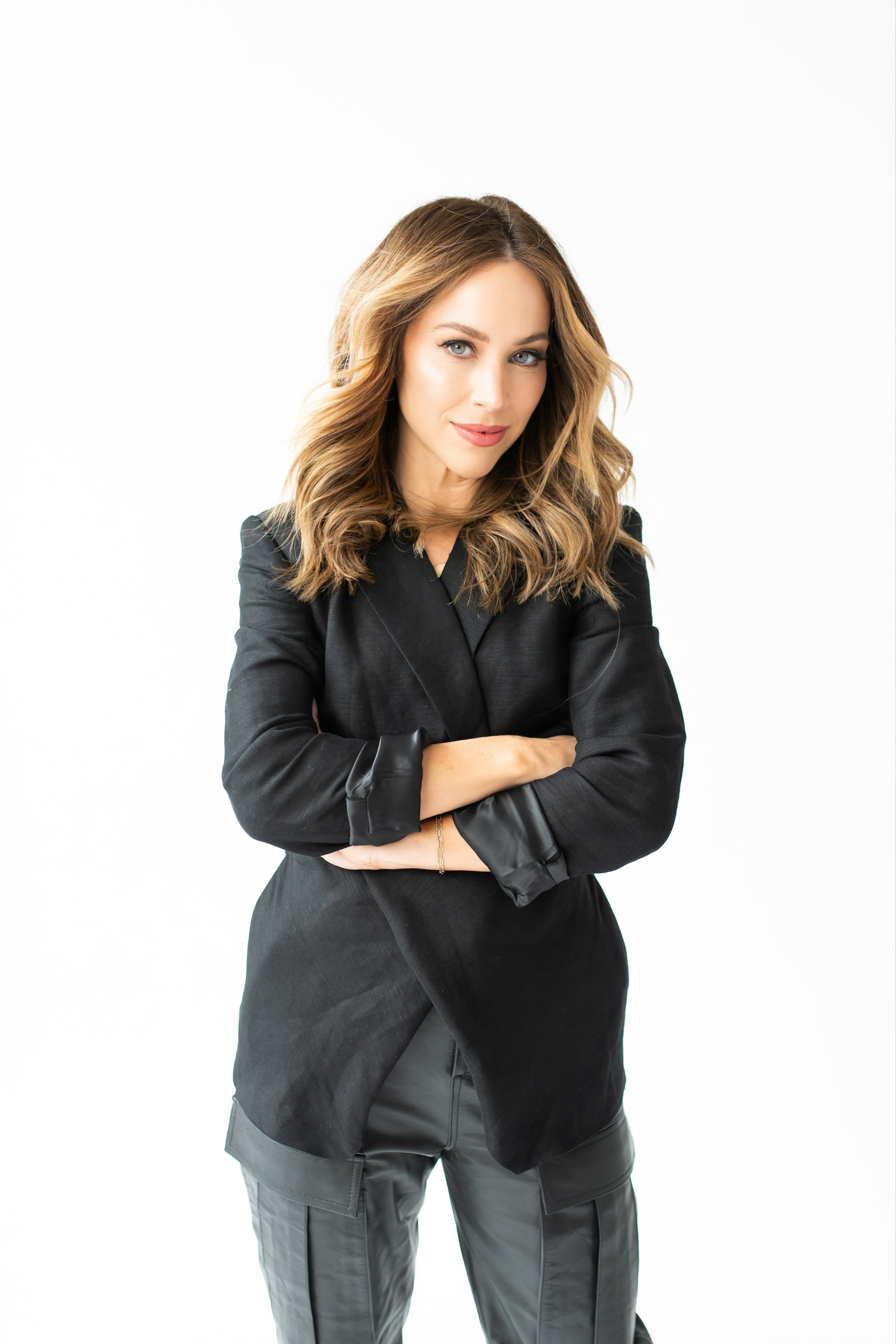How Courtney Shields Pitched an Innovative Clean Beauty Product Over Dinner and Turned It Into a Reality
“I didn’t want to just white label something, I wanted to be a part of the process.”
“
I didn’t want to just white label something, I wanted to be a part of the process.”
—Courtney Shields, Founder, CourtneyShields.com
Courtney Shields is the definition of a glow-getter.
Six years ago, she was a singer-songwriter looking to break into the music industry when she decided to take the leap and launch a blog to share her beauty and fitness tips. What originally started out as a passion project quickly proved to be a profitable business.
Fast-forward to today and that humble blog is now a multifaceted platform reaching thousands of daily readers and over 680K Instagram followers. It should come as no surprise that Shields has collaborated with all the major beauty brands, and this month, she launched her very first product, Glow Hour, with the innovative clean beauty brand TULA.
Like many of the best beauty products, the idea for Glow Hour was born from a personal need. Unable to find a brightening under-eye treatment she loved, Shields decided to create it herself—and she found the perfect in a brand she’d worked with for years: TULA. One evening while at a work dinner with reps for the brand, she took a sip of her wine, made the pitch, and the rest is history.
At Create & Cultivate’s recent Digital Beauty and Self-Care Summit, Maya Allen, a beauty editor at Marie Claire, virtually sat down with Shields to learn more about her multi-hyphenate career and her latest venture in the competitive clean beauty industry, including the night she summoned the courage to pitch the idea to TULA over tapas and wine.
Scroll on for all of the most memorable moments from the conversation, and be sure to grab a notebook and a pen because you’re going to want to write these quotes down.
On launching a beauty blog…
“I love helping women feel more confident.” - Courtney Shields
On cultivating inner beauty…
“Inside out, outside in.” - Courtney Shields
On partnering with TULA on Glow Hour…
“Choosing TULA was super easy for me.” - Courtney Shields
“I’ve been using their products for 5 years.” - Courtney Shields
“I wanted to work so closely with the team to create something from the ground up.” - Courtney Shields
“I didn’t want to just white label something, I wanted to be a part of the process.” - Courtney Shields
On the importance of getting started...
“You can always pivot as you go, but just start.” - Courtney Shields
On forging ahead during COVID…
“You can look at 2020 two ways. One way is you can choose to complain and feel stuck and frustrated, or you can use 2020 as an opportunity for growth.” - Courtney Shields
“There’s power in our perspective.” - Maya Allen
On not paying attention to the number of followers, likes, or comments…
“If you are seeking outside validation, you’re never going to be happy.” - Courtney Shields
On seeking work-life balance…
“You can have it all, but you can’t have it all at once.” - Courtney Shields
On prioritizing self-care…
“Go for the walk, take the bath, do whatever fills you up, otherwise you’re pouring from an empty cup.” - Courtney Shields
On standing out in a saturated space…
“You have to do what you’re passionate about.” - Courtney Shields
“Standing out in a saturated space is all about being yourself and being authentic.” - Courtney Shields
“If you start trying to emulate what everyone else is doing, you’re on an uphill battle.” - Courtney Shields
“Looking inward, figuring out what feels good to you, and then doing that full-force is so important.” - Maya Allen
On navigating negativity and naysayers…
“I’m not a jar of Nutella, I can't please everyone, no matter what I do.” - Courtney Shields
On the best advice she’s ever received…
“Don’t procrastinate. You’ve got to get it done eventually, so might as well do it now.” - Courtney Shields
On her purpose…
“Walking through hard shit and showing people that you can still do hard things with a positive attitude and come out on the other side.” - Courtney Shields
On not paying attention to the number of followers, likes, or comments…
“If you are seeking outside validation, you’re never going to be happy.” - Courtney Shields
On seeking work-life balance…
“You can have it all, but you can’t have it all at once.” - Courtney Shields
On prioritizing self-care…
“Go for the walk, take the bath, do whatever fills you up, otherwise you’re pouring from an empty cup.” - Courtney Shields
On standing out in a saturated space…
“You have to do what you’re passionate about.” - Courtney Shields
“Standing out in a saturated space is all about being yourself and being authentic.” - Courtney Shields
“If you start trying to emulate what everyone else is doing, you’re on an uphill battle.” - Courtney Shields
“Looking inward, figuring out what feels good to you, and then doing that full-force is so important.” - Maya Allen
On navigating negativity and naysayers…
“I’m not a jar of Nutella, I can't please everyone, no matter what I do.” - Courtney Shields
On the best advice she’s ever received…
“Don’t procrastinate. You’ve got to get it done eventually, so might as well do it now.” - Courtney Shields
On her purpose…
“Walking through hard shit and showing people that you can still do hard things with a positive attitude and come out on the other side.” - Courtney Shields
Shop Glow Hour
TULA Glow Hour
$32
MORE ON THE BLOG
Pro Tip: How to Convince Your Boss to Let You Go Freelance
Loving WFH?
Photo: Karolina Grabowska from Pexels
If you’ve been putting together a plan for leaving your 9-to-5 job and venturing into the brave new world of freelance, there’s a potential client I bet you haven’t stopped to consider yet: your current employer.
When I started my freelance career, my first client was the same PR agency I’d been working for over the last two years. There were things outside of work I needed to be able to dedicate my time to but I was committed to my job and team. I loved what I was doing, but I also craved the freedom of flexibility and autonomy.
If this sounds like you, keep reading because in today’s Pro Tip I’m going to share my step-by-step process for how to convince your boss to let you go freelance.
Pinpoint Your Value
The most important factor in convincing your current employer to let you switch from full-time to freelance is to pinpoint the unique value you bring to their business.
For me, it was my knowledge of and connections within the video game and esports industries. Beyond my expertise, my proven loyalty and track record for being a high performer also helped contribute to my cause. I had just been promoted about six months prior and worked well with my team and clients.
Once you have your unique value identified, gather important milestones you’ve hit throughout your time with the company. I like to focus on quantifiable milestones because numbers are the best way to communicate results to your boss. For my situation, this was the amount of new business I helped secure for the company, additional retainers I negotiated with existing clients, high-profile news hits I secured for product launches, etc.
Do Your Research
Freelancing is far from a new concept, but nowadays, more and more businesses are embracing this change in the workforce. Before you approach your boss with your freelance plan, do your research to make sure that freelancing is actually something you can afford to take on.
When you’re a freelancer, you’re forfeiting your company-provided benefits like healthcare, 401K matching, and paid vacation days. So take time to do some research and make sure that you’re ready for the change.
You also want to make sure that the jump from full-time to freelance is sustainable within the company you’re working for. Meaning to say, that you can continue to not only show your value but identify areas where you can continue to pick up additional work when projects end.
If you’re looking for more guidance on things to take into consideration before starting your freelance career, get your hands on my freelancer starter kit.
Create a Plan
The last thing you want to do is pitch the idea of freelancing to your boss without a plan in place. You’re asking for a significant change and in order to get the best outcome, you’ll need to prove that going freelance is the best route for not only you but your employer’s business goals.
Start by looking at the next six to twelve months and identify key moments where you regularly play a significant part in the business. For me, this was around client conferences and product launches. Once you have those key moments in place, think of the value you add to those occasions and the amount of time it typically takes to complete the necessary work-related tasks.
Freelancing is about hourly rates. Even if you negotiate a monthly retainer, you want to make sure you’re being compensated for the amount of work you agreed to for the amount of time estimated so you don’t fall back into what could feel like a 9-to-5 grind.
After you identify your value and key business moments, list the types of tasks you want to do as a freelancer to help support them. Then look at what you’ve written out to determine if it’s too little or too much work to support your freelance goals. From there, adjust where you need to and start to imagine how you’d like to bring this up to your boss.
The Pitch
Let’s recap before you schedule a time to sit down and pitch the idea of freelancing to your boss you want to have the following:
A clear understanding of the unique value you bring to their business.
Confidence through the research you’ve done that you’re ready for freelance life.
A plan of action for how you will transition to and execute freelancing so effortlessly, they’ll hardly notice the difference.
Once you have these three factors in place, ask your boss to schedule a time for a one-on-one conversation. It’s important this meeting be scheduled for a time with minimum distractions. For example, if you know your boss is particularly busy in the mornings, aim for the afternoon.
Start the conversation with confidence. This is a proposal you’re pitching, not a favor. Switching to freelance is a business-related request so don’t go into the meeting thinking that you’re going to appear weak or less-than for asking for something that you want.
Start with something like this:
“I would like to discuss the opportunity of transitioning to a freelance employee with you today. I’ve created a plan of action that I’d like to share for how I can continue to add value to your business in this new capacity. I enjoy working with you and hope this is something you will take into consideration.”
This messaging is clear, to-the-point, and friendly. From here, share your plan and ask for feedback along the way.
Be prepared to answer questions like:
Why do you want to switch to freelance?
What hourly rate are you expecting?
How many hours a week can you commit to?
Are you willing to come into the office?
How long do you want to freelance for?
Every individual’s answers will be different so it’s important to think of what you want from the setup. Be prepared for where you’re willing to compromise and where you are firm. Having clear answers will make the decision-making process much easier for you and your boss.
About the Author: Audrey Adair is a seasoned freelance communications professional and founder of The Scope, a platform providing resources and community to freelancers and the self-employed. Connect with The Scope on Instagram and join the email list to receive your free resource, The Freelancer Starter Kit.
This post was published on March 19, 2019, and has since been updated.
Love this story? Pin the below graphic to your Pinterest board.
MORE ON THE BLOG
4 Ways to Make Your Side Hustle Happen When You’re Working Full-Time
Join the side hustle gang.
Photo: Ivan Samkov from Pexels
I really like my job, but I’m not sure it’s fulfilling me or fueling my passions.
It would be great to have a second income for all the little extras life throws my way.
If the economy plummets, will they even hesitate to lay me off?
I wish I didn’t have to report to anyone and could create my own schedule.
Sound familiar?
All of these were thoughts that used to cross my mind at least three times a day. And of course with ambition, dreams, and motivation, came their cousins: fear, worry, and doubt.
Where do I even begin? Will I be successful? Will people like me? I studied PR...do I really know anything about anything else? Where will I find the time?
More questions, more worry, more doubt.
It wasn’t until I became overwhelmed with my own questions that I decided to put them all behind me. On mute. To be addressed later... or possibly never. I began to question less and do more. Where do I start? Here. What do I do? This. Will I succeed? Yes. Where will I find the time? Goodbye, Netflix binging.
The only thing I didn’t question was whether I’d leave my full-time job because after all, I truly do love what I do. And let’s be real, benefits like a fixed salary, insurance, and a 401K were simply non-negotiable, considering I didn’t have a single dollar in savings (insert mortified emoji) and relied on my salary alone to survive. (In my defense, I recently bought a home which, ironically, is the inspiration behind my side hustle: White This Way Home).
Wanna join the side hustle club? Here are my top tips for starting your own gig without leaving your full-time job:
Stick to a schedule.
Time is your best friend—but also your biggest enemy, if you don’t set a working schedule and stick to it. Even if your full-time job is flexible, make a commitment to limit distractions while you’re in full-time work mode. This means you try not to look at side hustle-related emails, social media, or comments during full-time work hours. Instead, leave it for nights and weekends. The good news (if your side hustle relies heavily on Instagram) is that there are a number of apps that let you schedule posts ahead of time (I use Plaan).
2. Capture thoughts to revisit.
OK, we’re all human—it's so easy to daydream about a new project or dwell on your side hustle to do list during your full-time work hours. After all, to-do lists are endless and inspiration can strike out of nowhere. You never know if and when these thoughts and daydreams will come back to you, so it’s important to take a moment to capture the ideas before they float away. Keep these inspirational thoughts in an imaginary bottle (or your phone, in a notebook, or on a sticky note), and rest assured they’ll be there when you have time to revisit them.
3. Find balance.
Feeling drained and overworked can be counterproductive. Don’t forget to build in time for fun, which can actually work in your favor and help refill your energy tank (ever tried driving on a completely empty gas tank? The epitome of counterproductive). Feeling energized and balanced is not only essential to getting things done, but it also gives your mind space for ideas to evolve and grow, even when you’re not actively in brainstorm mode.
4. Give yourself a pep talk.
Sure, you might look like a crazy person talking to yourself, but this really works! You can’t convince others to believe in what you do if you don’t believe in what you do. If those feelings of worry, fear, and self-doubt start to creep in, give them one answer in return: “I can and will do this.” Self talks, motivational quotes, little hand-written reminders, and a 24/7 “I’m a badass” attitude goes a long way. And the beauty of it is that you can pep talk anywhere, even during regular business hours.
About the Author: Adriana Infante is a PR + Marketing professional based in Miami, FL. She is also the founder of @WhiteThisWay an in-house product styling company that helps clients design spaces to reflect their personal styles and needs by harmoniously combining simplicity and tidiness to create a stylish, yet functional home.
Love this story? Pin the below graphic to your Pinterest board.
This post was published on February 19, 2019, and has since been updated.
MORE ON THE BLOG
How a Digital Nomad Built a Multi-Million Dollar Business While Working Part-Time—With Just $800 and a Laptop
And how you can too.
Photo: Taryn Elliott from Pexels
Ever since I was little, I remember being told that I had to work hard, get good grades, go to college, get a job, make money, and then I could do what I wanted. Except, I didn’t want that for myself. I didn’t want a 9-to-5 job, counting down the days until my next vacation. I wanted something more.
I just didn’t know how to get it.
For a long time, I was torn between joining the Peace Corps and getting a degree in comparative politics. I even thought about attending law school, but I knew it wasn’t what my soul really longed for. While all of the above would have absolutely satisfied the approval of others, it wasn’t what I wanted. I wanted to travel the world, and I didn’t want to wait years until my bank account made it possible.
During my senior year of college, I started to think about creative ways I could earn money while traveling. Blogging was an option, especially since I already had a website and a logo, so I figured I could trade services for accommodations. However, since both of my parents are financial professionals, I realized that monetizing a travel blog would be challenging (and improbable).
Without a better plan in place, I decided to take the leap anyway. Before I knew it, I bought a one-way ticket to Bali armed with my laptop and $800.
“Success doesn’t happen overnight, but—with hard work—it can happen pretty fast.”
When I first arrived in Bali, I was making $12 an hour as a social media manager. I even worked for free or low-paying positions in return for testimonials, and that hustle paid off. I built a foundation of testimonials and referrals as quickly as possible, and I started to attract more clients. In my first month, I made $5,000.
Except, I was doing it the wrong way. I was working way too hard, I was overloaded with clients, and I’d trapped myself in a self-employed version of the same corporate grind that I sought to escape. Here I was, living in Bali, but I was working so hard that I couldn’t even enjoy it.
I could keep doing what I was doing, sure, building a business trading time for money, or I could take a leap of faith into something new.
I decided to invest in my own business coach, spending $3,600 that I could barely afford on hiring my first mentor, but the investment paid off in a huge way. Soon, I hit my first five-figure month. Then it doubled. Suddenly, I was bringing in $50,000 a month and landing features in Forbes and Business Insider. Within a year, I was a self-made millionaire working less than 15 hours per week from all around the world, and it’s been growing ever since.
And while starting a business definitely has its triumphs and tribulations, here’s what made it possible and how you can do it too.
1. Be very intentional about everything you do.
You need to know why you’re doing what you’re doing. Far too many people get caught up in chasing money or some other arbitrary version of success. What do you want? What actually drives you?
I knew I wanted a business that gave me the freedom to travel the world, so I created a business model that allowed for that. Most businesses choose one of two pricing models, either premium pricing for a few clients or low pricing to serve a massive amount of people.
My business is built on both. By creating multiple streams of income, I can help as many people as possible and hit my income goals without working 80 hours a week. It’s all about being intentional and strategic in choosing what works for you.
2. Never, never never give up.
I moved halfway around the world by myself, so it’s no surprise that I thought about packing my bags, going home, and giving up. Fear started to slowly creep into my life, especially when it came to visibility. I convinced myself that other people would make fun of me for what I was doing, and it was my weakness for the longest time.
At one point, I was ready to quit. I went home for Thanksgiving, and my dad told me to give it six more months. Just six more months. Sure enough, I returned to Bali and my business exploded.
I was ready to let my own limiting beliefs hold me back. I wasn’t sure how I was going to get there, and the unknown can be incredibly scary. However, you’ll never reach your destination in life if you give up.
3. Focus on personal branding and build a community.
Once I started to build up my personal brand, a strong community began to form. I focused on creating a unique, visual brand that allowed me to share my own story so that I was able to stand out and attract the right followers for my business.
Then, I started to establish a presence on social media and connect with my audience on a much deeper level. As a digital nomad, having a strong brand on social media is the reason why I’m able to run my business from all the different countries I travel to. It allows me to establish a global, online presence and continue to attract the right clients regardless of the geographic location.
Plus, there’s no better feeling than having your audience root for you. People want to see you succeed, and you get to witness the direct impact your business has on other people’s lives. That’s incredibly fulfilling.
4. Create content that provides real value.
If you want to connect with your audience in a huge way, then you need to be practicing value-driven marketing. Whether you’re creating podcasts, live streams, long-form blog posts, YouTube videos, Instagram Lives, or something else—what you’re creating doesn’t matter. Just make it valuable.
Remember, everyone’s journey is unique. Some people crave freedom. Others want the ability to spend more time with their families. Maybe you dream of achieving location independence. All of these things are doable, but it all starts with a choice.
And once you know exactly what you want out of life, it becomes way easier to create the business you want around it.
“Once you know exactly what you want out of life, it becomes way easier to create the business you want around it.”
—Sabrina Philipp, International Online Business and Social Media Expert
About the Author: Sabrina Philipp is an international online business and social media expert who has been featured in Forbes, Business Insider, Marie Claire UK, and more. She helps entrepreneurs build intentional, manageable, and profitable businesses so they can experience ultimate personal and financial freedom.
Opting to skip the traditional 9-to-5, Sabrina moved to Bali with $800 to her name. Within a year, she built a thriving million-dollar business from her laptop. Currently traveling the globe with her fiancé Paul, Sabrina has a loyal community of over 100,000 business owners who follow her closely to see where in the world she’ll inspire them from next. You can follow her on Instagram at @sabrinamphilipp.
MORE ON THE BLOG
Help! The More I Make the Less I Save
Is your bank account up in flames?
Does it feel like with every passing year, and every (hopefully) subsequent raise and bonus, life's expenses keep going up to? It's not in your imagination.
According to Nerd Wallet, "the rise in the cost of living has outpaced income growth over the past 13 years. Median household income has grown 28% since 2003, but expenses have outpaced it significantly. Medical costs increased by 57% and food and beverage prices by 36% in that same span."
Since 2009, most Americans have said they prefer saving over spending, but the fact remains that the average overall U.S. household debt increasing by 11% in the past decade. Today, the average household with credit card debt has balances totaling $16,883.
To adjust to the growing cost of living, we have to re-examine our relationship to money. It's not the only source of wealth and it's not only for spending. Obviously, you should be spending less than you make. But old models don't apply to new costs. For example when it comes to rent: The general recommendation is to spend about 30% of your gross monthly income (before taxes) on rent. Therefore, if you'll be making $4,000 per month, then your rent should be $4,000 x 0.3, or about $1,200. Those numbers don't really work when rent has been steadily increasing across the country, while wages do not.
So what's a working woman to do? Changing your mind about money is one solution.
Laleh Hancock teaches people how to uncover their own unconsciously held beliefs about money to experience greater wealth. Some of her top tips include:
1. Be willing to explore your beliefs around money
If you grew up in a family that said money is evil, you have to work hard to make money, or men should earn more, you may have adopted it as your own belief, even if it’s not. Ask yourself: If I had no belief about money being good or bad, what are all the different areas money can come into my life or my business?
2. Write a list of things you do and don’t enjoy... and question it all
It’s possible the things you ‘don’t like’ are on the list because other people have said it’s a chore, boring or hard work. Things you thought you didn’t like, but do, could become an extra source of revenue for you. Ask yourself: Do I really enjoy this? Do I really not enjoy this? And what is it that I do or do not enjoy about this, and what would make it more enjoyable?
3. Allow the business to work for you instead of you working for your business
Your business has a consciousness. Instead of trying to control everything in the business, partner with its energy for guidance instead.“Most of us work a million hours thinking we have to control everything in the business,” Laleh says. “If we are willing to allow the business to work for us, however, the business will draw in clients and staff for you.” Ask the business questions every day: What do you require from me today? Who would you like me to contact today?
4. Be open to change every day
Your money or business goals and decisions are not set in concrete. Be open to making a different decision every day, every hour or even every 10 minutes. “You have to know when it’s time to change and be willing to move in a new direction,” Laleh says. Ask yourself: is this what I want to be working on?






























